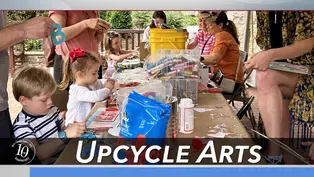
Wagon Roads
Clip: Season 10 Episode 24 | 5m 26sVideo has Closed Captions
Discover the origins of roads and their link to Native Americans.
Discover the origins of roads in Carolina. Learn how Native American trading paths provided the foundation for the roads used by European Settlers. And visit a portion of the Great Wagon Road preserved at the Anne Springs Close Greenway in Fort Mill, SC.
Problems with Closed Captions? Closed Captioning Feedback
Problems with Closed Captions? Closed Captioning Feedback
Carolina Impact is a local public television program presented by PBS Charlotte

Wagon Roads
Clip: Season 10 Episode 24 | 5m 26sVideo has Closed Captions
Discover the origins of roads in Carolina. Learn how Native American trading paths provided the foundation for the roads used by European Settlers. And visit a portion of the Great Wagon Road preserved at the Anne Springs Close Greenway in Fort Mill, SC.
Problems with Closed Captions? Closed Captioning Feedback
How to Watch Carolina Impact
Carolina Impact is available to stream on pbs.org and the free PBS App, available on iPhone, Apple TV, Android TV, Android smartphones, Amazon Fire TV, Amazon Fire Tablet, Roku, Samsung Smart TV, and Vizio.

Introducing PBS Charlotte Passport
Now you can stream more of your favorite PBS shows including Masterpiece, NOVA, Nature, Great British Baking Show and many more — online and in the PBS Video app.Providing Support for PBS.org
Learn Moreabout PBS online sponsorship(gentle music) - [Jason] Did you know that more than 140,000 miles of public road weave between North and South Carolina?
Kind of amazing when you think about it.
For the most part, say other than the traffic jams and stoplights, roads and highways make getting to wherever it is you're going a bit easier.
And well, it's easy to maybe take them for granted.
- You know, get on the road and we just assume that this is the road and that some city planner came up with this road, you know, maybe 50 years ago or 100 at the most.
- [Jason] But well before these paved pathways of mobility provided us with the ability to move freely about the country, there existed something else.
a piece of forgotten infrastructure.
a network of prehistoric path that evolved into our modern road system.
We hit the road to Lancaster, South Carolina in the Native American Studies Center where we asked Dr. Stephen Criswell just how indigenous people traveled.
- It's important to note that these paths that we still follow today were created by Native Americans thousands of years ago.
And persisted, you know, if something works, human beings keep doing it (laughs) and they stick with it.
And we owe our ability, in some ways, to get from one part of the Carolinas to the other, to get to Atlanta, to get to Virginia because of these paths that were laid out thousands of years ago.
Sometimes referred to as the Great Trading Path, the Great War Path, the Great Warrior Path.
And that path then later became the Great Wagon Road.
That was the path used by Scottish and Irish settlers who came down from Pennsylvania and then settled into the area.
- [Jason] Amazingly, some segments of these historic paths still exist.
At Anne Springs Close Greenway in Fort Mill, there's a well preserved section of the Great Wagon Road known as Nation Ford Road.
- [Stephen] You know, some of the first settlements were all along these trade paths.
When you get to waterways, you start seeing more and more settlement.
That's why Nation Ford was so important because it was a place to cross the Catawba River.
- [Jason] Flora Doraski knows a bit about the area's history.
She volunteers at both the Fort Mill History Museum and the Greenway.
- Mostly Scott Irish coming from the Philadelphia area, coming into this area.
And part of the attraction here was that, especially in the mountains, it reminded them of home.
Of the Highlands.
- [Jason] Back in the 1700s, if early settlers wanted to make the move from Pennsylvania down the Great Wagon Road, they couldn't just call a moving company or hop on a highway.
- [Flora] They were using Conestoga wagons.
Now the Conestoga wagon was built in Conestoga, Pennsylvania.
- [Jason] A hike along this segment of Nation Ford Road gives you a pretty good idea of the considerable effort Native Americans and the early pioneers had to make just to get around.
- There's some areas that are pretty improved but there are some areas that give you more that idea of what it was like to be walking along that wagon.
Lots of roots, lots of rocks and it gives you an appreciation for coming through here.
I mean, it's not like modern interstates today.
Though, in a way, that's what it was in its time.
- [Jason] While not the multi-lane highways of today, roads like Nation Ford made trade possible amongst Native Americans and European settlers.
According to Criswell, the Catawba benefited from their unique location along the road.
- Once English and European settlements started, these paths really became the trade route.
And the Catawba, in some ways, acted as the middleman in the deer trade between the European settlers and the other tribes who would acquire deer skins because the Catawba were right at a crossroads there where the trade path came down and split into two directions where you could go toward the English settlements, the European settlements in one direction and the Cherokee and other tribal groups the Saluda and so forth in the other direction.
(birds chirping) - [Jason] In 1780, after British forces were defeated at the Battle of King's Mountain, British General Cornwallis who was headquartered 20 miles away in Charlotte, used Nation Ford Road to retreat along with around 4,000 troops across the Catawba River and to regroup in Waynesboro, South Carolina.
Almost 85 years later, at the end of the Civil War, Nation Ford Road once again offered an escape route.
This time, it was the defeated Confederate president Jefferson Davis, along with his cabinet, as they fled federal troops.
Eventually, segments of the original road were abandoned like here at the Anne Springs Close Greenway.
But Criswall says "Today, most of us don't even realize "that much of the Great Trading Path "is actually still in use."
- The paths now take the form of, in the interstates, the major highways, as I said, highway 21, I77, I85 follow much of what was the Great Trading Path.
And then there are still portions of it, I think, in certain states that some of these paths have become greenways and trails to follow for hikers and so forth.
- [Jason] So the next time you hop in your car for a little road trip, just think about how the roads we travel originated.
Why does it curve here or go there?
For "Carolina Impact," I'm Jason Tersiz reporting.
Video has Closed Captions
Clip: S10 Ep24 | 5m 25s | Carolina Farm Trust works to help local farmers and keep local produce in the region (5m 25s)
Carolina Impact: May 9th, 2023 Preview
Preview: S10 Ep24 | 30s | PBS Clt and NewsHour on Medicaid, Carolina Farm Trust, Upcycle Arts, & the Great Wagon Rd. (30s)
NC Medicaid: 'We Feel Silenced'
Video has Closed Captions
Clip: S10 Ep24 | 7m 18s | In NC, more Medicaid. But not for everyone. Team coverage from PBS Charlotte and NewsHour. (7m 18s)
Video has Closed Captions
Clip: S10 Ep24 | 4m 1s | Upcycle Arts' is Charlotte's first creative reuse center selling donated items and art sup (4m 1s)
Providing Support for PBS.org
Learn Moreabout PBS online sponsorshipSupport for PBS provided by:
Carolina Impact is a local public television program presented by PBS Charlotte














